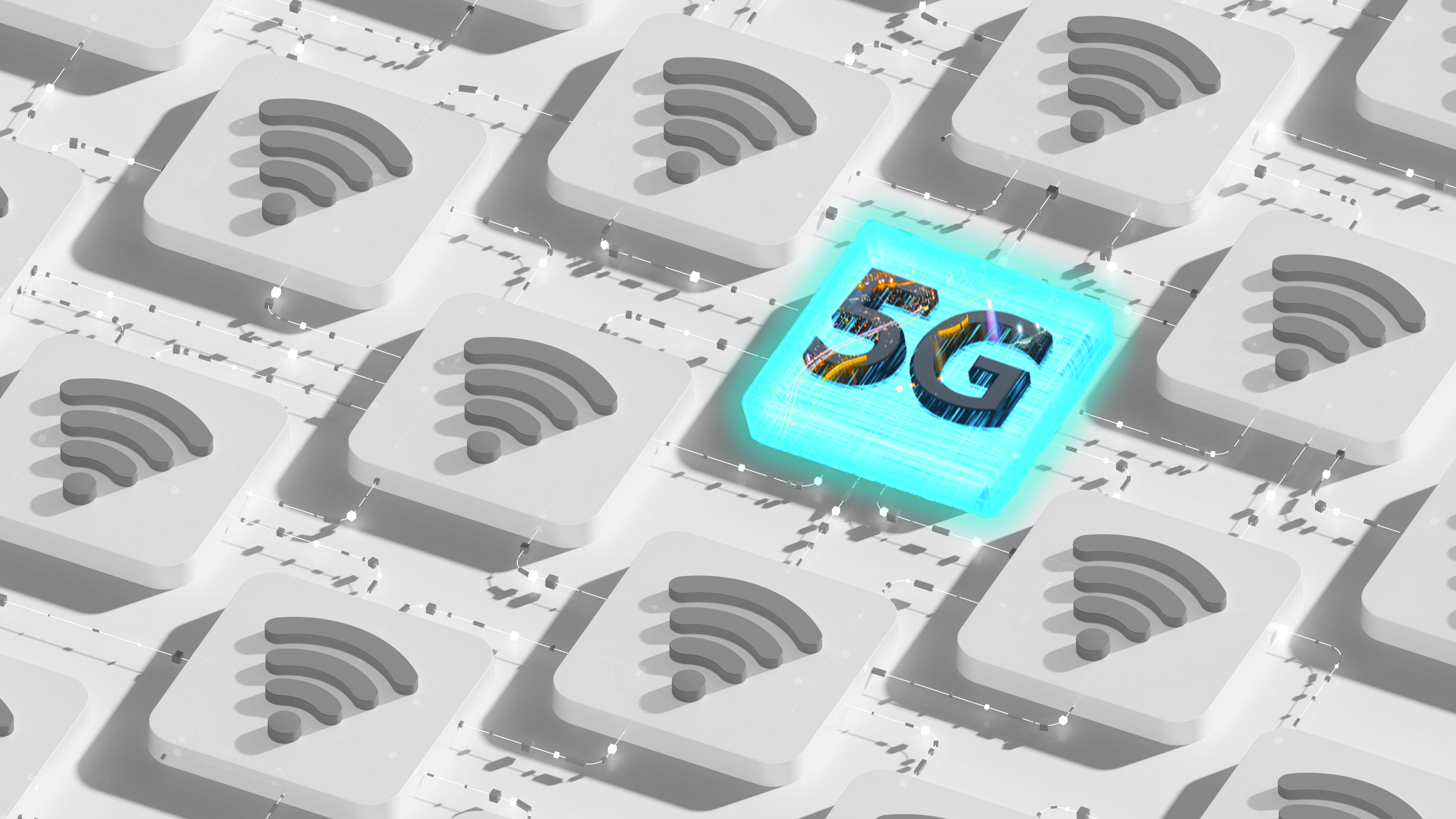Wi-Fi vs 5G: Is it time your business ditched broadband?
5G adoption is picking up and promises to solve networking woes for businesses on the move, but is it a Wi-Fi killer?


This article originally appeared in issue 26 of IT Pro 20/20, available here. To sign up to receive each new issue in your inbox, click here
Employees' home Wi-Fi routers were among the heroes of the pandemic. Many businesses survived lockdown thanks to their workers' Wi-Fi networks. Dusty, old routers won’t cut it, though, if the same businesses want to stop merely surviving and, instead, compete in a data-hungry world with a mobile workforce. With traditional Wi-Fi often patchy and unreliable, it may be tempting to consider 5G alternatives as the answer.
The truth is, it’s absolutely a viable option. In fact, according to an NTT report, 90% of executives expect private 5G to become their standard network of choice in the future. Vodafone, meanwhile, calculates 5G could add £6.3 billion annually to the UK manufacturing sector by 2030.
Ditching Wi-Fi for 5G isn’t such a mad idea. The mass working from home shift was a shock for wireless networks, leading to interference and outages. As frustrated employees tethered their newly 5G-enabled phones to cover yet another outage, they may have pondered using this fast, reliable connection for all their work. It would also free them from the limited range of Wi-Fi to work wherever they want.
For businesses, 5G's appeal lies in key technical advances including huge bandwidth and dramatically lower latency – as low as 1ms. Ultra-low latency renders 5G smoother and more reliable than Wi-Fi, and enables much wider applications such as virtual reality (VR), artificial intelligence (AI) and the Internet of Things (IoT). Thousands of smart devices like factory and hospital robotics can be connected simultaneously, for instance. Also, while 4G focused on outdoor (macro) coverage, 5G can be installed across an entire site – indoors and outdoors – using private 5G cells.
"5G supports so many more devices, plus the latency you need for certain applications,” James Bristow, SVP EMEA of connectivity solutions provider Cradlepoint, tells IT Pro. “We're seeing it going into large seaports, airports, manufacturing plants. These environments are typically hostile for wires, or even for Wi-Fi because of its limited range."
Check the price tag
RELATED RESOURCE

Four strategies for building a hybrid workplace that works
All indications are that the future of work is hybrid, if it's not here already
FREE DOWNLOAD
Although 5G's benefits are clear, and executives are dazzled, organisations haven’t yet rushed to build their digital strategies around the technology. That, says senior IEEE member and former Ofcom director William Webb, is because it's so expensive.
Get the ITPro daily newsletter
Sign up today and you will receive a free copy of our Future Focus 2025 report - the leading guidance on AI, cybersecurity and other IT challenges as per 700+ senior executives
"It's not yet clear how much it would cost a factory to put in a 5G network, but my guess is at least ten times more than Wi-Fi, because it's a much more complicated solution," says Webb. "You're faced with £5,000 on a Wi-Fi network, or at least £50,000 on a 5G system. Now, in some cases, the £50,000 will be the right choice, but you'll need to think carefully before you make that decision. You have to be sure you'll see a significant benefit."
"It is a challenging business case," agrees Tiago Rodrigues, CEO of the Wireless Broadband Alliance (WBA), who points out it's not just the cost of installing a network but also data, which is much more expensive than broadband, and new devices. Cellular devices, unlike Wi-Fi devices, tend not to be backwards compatible.
"We did a pilot study with a UK manufacturing company that builds parts for aeroplanes," says Rodrigues. "In the end, they chose Wi-Fi instead of 5G, and backwards compatibility was critical in that. I can pick up a Wi-Fi 3 laptop from 15 years ago, and it'll work on Wi-Fi 6. If I go with 5G, I'll need to change devices every two years, because you'll have 6G, 6-and-a-half G, then 7G."
What about Wi-Fi 6?
Wi-Fi isn’t about to be left behind. The new Wi-Fi 6 standard is many times more battery-efficient than 5G, not to mention cheaper. It's also much less liable to interference than Wi-Fi 5, removing a key frustration for companies sharing large spaces such as shopping centres.
"Wi-Fi 6 brings back some of the things people are looking to 5G for, such as smoother latency and higher capacity," Freeform Dynamics analyst Bryan Betts tells IT Pro. "If I were a small business now, though, I'd be looking at one of the newer Wi-Fi setups that adds support for 5G, such as a router that'll take a SIM card as a backup."
5G is best used as a connectivity backup, agrees Aruba CTO Simon Wison, even if your workers are constantly on the move. "If you have a heavy Road Warrior, or somebody who works from home a lot, then devices with 4G/5G backup capability are very useful,” he says. “Don’t pay for gigabytes and gigabytes of data that you're not going to use, though." Wilson adds that in his experience, Wi-Fi 6 is so reliable it offers better connectivity than "a good old wired network".
The ultra-low latency and huge bandwidth of 5G still make it the wisest investment for certain sectors, such as factories operating robotics. But for most businesses, it makes more financial sense to invest in the best Wi-Fi available, and have access to 5G for the occasions that call for it. With Deloitte finding that 98% of decision-makers intend to use both Wi-Fi 6 and 5G within two years, it seems businesses are already thinking along these lines.
Making convergence work
The future for connectivity can’t be seen through the prism of 5G versus Wi-Fi; “winning” mean a convergence of both. Businesses will increasingly use devices and services that switch between Wi-Fi and cellular automatically and securely. As Tiago Rodrigues puts it: "Wi-Fi is the best friend of cellular."
In China and South Korea, convergence has taken several steps forward. For example, SIM cards automatically authenticate users within certain Wi-Fi networks, such as some business premises. A similar experience is on offer within a handful of UK sites thanks to programmes such as OpenRoaming, which covers London's Canary Wharf and Olympic Stadium, and Eduroam, a seamless Wi-Fi and 5G network across the world's universities. Securely connected areas like these are set to roll out to more UK and global locations in the coming months, letting users stay online without having to keep authenticating themselves.
If we peer into the further future, Wi-Fi will remain fully relevant. The likely next step for convergence is multipath TCP, a protocol which connects devices to both types of network at once, automatically delivering the maximum throughput for whatever app needs it. Some data packets will come from 5G and some from Wi-Fi, intelligently combining to deliver the best experience, whether you're showing video to clients or examining X-Rays using augmented reality (AR).
Our advice? Don't rush to swap your office's routers for 5G cells or your mobile workers' laptops for phones; the future of business connectivity isn’t 5G or Wi-Fi – it's both.
Jane Hoskyn has been a journalist for over 25 years, with bylines in Men's Health, the Mail on Sunday, BBC Radio and more. In between freelancing, her roles have included features editor for Computeractive and technology editor for Broadcast, and she was named IPC Media Commissioning Editor of the Year for her work at Web User. Today, she specialises in writing features about user experience (UX), security and accessibility in B2B and consumer tech. You can follow Jane's personal Twitter account at @janeskyn.
-
 Bigger salaries, more burnout: Is the CISO role in crisis?
Bigger salaries, more burnout: Is the CISO role in crisis?In-depth CISOs are more stressed than ever before – but why is this and what can be done?
By Kate O'Flaherty Published
-
 Cheap cyber crime kits can be bought on the dark web for less than $25
Cheap cyber crime kits can be bought on the dark web for less than $25News Research from NordVPN shows phishing kits are now widely available on the dark web and via messaging apps like Telegram, and are often selling for less than $25.
By Emma Woollacott Published